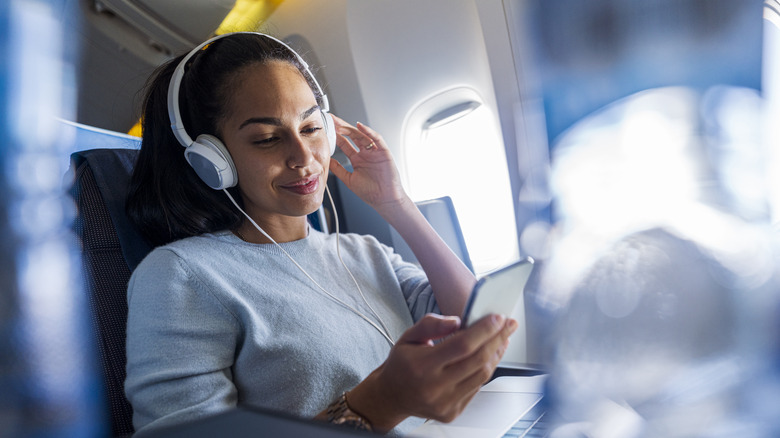These Types Of Headphones Are The Unexpected Secret To Better-Tasting Plane Food
If you've flown, it's a good bet you've complained about how bad airplane food can taste. It's a joke for the ages, and while there are some not-so-bad meals out there, not all of them are exactly gourmet. Maybe the issue with your in-flight meal is how it's prepared, or perhaps you just don't like the taste. Food and drink do taste different on planes, like bloody marys, which are said to be even better several thousand feet in the air. However, there is an interesting theory about how using headphones can make your food and drinks taste better in-flight. The simplified reason is that low noises, like the plane rumbling, can make your food taste more bitter.
Charles Spence, professor of experimental psychology at the University of Oxford, told The Boston Globe that sound "is the forgotten flavor sense." While experimenting with how music can affect taste, he found that our perception of bitterness can increase up to 10 percent with low tones. That means that those noise-cancelling headphones you bought on Amazon Prime Day are about to come in very handy. The dampening of the low pitches may make your food less bitter-tasting while keeping your ears safe from the loud kid behind you. There is more to the story, from the experiment to what makes things taste sweeter, to other things that affect your sense of taste.
If low noises make food taste bitter, what makes them taste sweet?
Professor Spence told the Independent, "The lower cabin pressure, dry cabin air, and loud engine noise all contribute to our inability to taste and smell food and drink." His study at Heston Blumenthal's Bray, U.K., restaurant, The Fat Duck, shed some light on this. One part of the study had subjects taste bittersweet candy while listening to music. According to the results, the flavor was more bitter when they heard low pitches from brass instruments, while it tasted sweeter when accompanied by a high-pitched piano.
Noise-cancelling headphones work through a microphone inside. It analyzes the ambient sound waves around you and produces the opposite sound waves to cancel it out. That means less of the deep noise. One might then draw the conclusion that listening to light, high-toned piano music through noise-canceling headphones while eating may make your food seem sweeter. It would certainly be a fun experiment to try on your next flight.
Regular headphones would lower the amount of sound you're hearing from the plane, though less so than noise-cancelling ones. However, noise in general can have an effect on taste. According to a 2015 study in the Journal of Experimental Psychology: Human Perception and Performance, it was noted that when background noise reached the levels of a flight in the air, people were less able to taste sweet and more able to taste umami or savory flavors.
Something else that can affect taste on planes
It appears from these two studies that noise-cancelling headphones reducing sound in general may help with sweetness perception, and more so if you're listening to tinkling high tones. Another thing to note is that, as Professor Spence mentioned, dry cabin air can make it harder to taste things. It's a good idea to stay hydrated on the plane. However, it's probably worth bringing your reusable water bottle and filling it at the airport. Skip plane water (unless it's from a bottle) and ice as the tanks aren't cleaned often which causes the growth of microbes, as a 2015 study in the International Journal of Environmental Research and Public Health showed. Adding individual packets of sports drink to the water in your reusable bottle can help with dehydration.
Before you go rushing out to purchase noise-cancelling headphones, there is something else. It's not a great idea to wear them while walking around a new city, exploring alone, or in places where you need to hear traffic. Something or someone can come right up to you without you realizing it, causing safety issues. It's best to keep them for things like shutting out noise as you work from home, tuning out the construction work outside your office, or on planes to bump up the taste of your in-flight meal.
